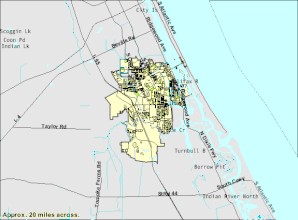Port Orange
| Port Orange | |
|---|---|
|
County and state location
|
|
| Basic data | |
| Foundation : | 1867 |
| State : | United States |
| State : | Florida |
| County : | Volusia County |
| Coordinates : | 29 ° 7 ′ N , 81 ° 0 ′ W |
| Time zone : | Eastern ( UTC − 5 / −4 ) |
|
Inhabitants : - Metropolitan Area : |
56,048 (status: 2010) 496,575 (status: 2006) |
| Population density : | 875.8 inhabitants per km 2 |
| Area : | 69.1 km 2 (approx. 27 mi 2 ) of which 64.0 km 2 (approx. 25 mi 2 ) are land |
| Height : | 2 m |
| Postcodes : | 32123, 32127-32129 |
| Area code : | +1 386 |
| FIPS : | 12-58575 |
| GNIS ID : | 0295559 |
| Website : | www.port-orange.org |
| Mayor : | Donald O. Burnette |
 Map of the United States Census Bureau |
|
Port Orange is a city in Volusia County in the US state of Florida with 56,048 inhabitants (as of 2010).
geography
Port Orange is bordered by the cities of Daytona Beach , Daytona Beach Shores , South Daytona, and New Smyrna Beach . The city is about 35 km northeast of DeLand and 80 km north of Orlando .
history
Port Orange was founded in 1867 by Dr. John Milton Hawks founded on the banks of the Halifax River. Dr. Hawks was a surgeon in the United States Army and founded the Florida Land and Lumber Company with other officers of the Union Army after the Civil War and settled 500 freed slaves north of Spruce Creek on the Halifax River. In 1867, Dr. Hawks the settlement, which he initially called Orange Port, to its current location. Since this place name already existed, he renamed the settlement Port Orange in the same year.
Demographic data
According to the 2010 census, the then 56,048 inhabitants were distributed over 27,972 households. The population density was 875.8 inh / km². 91.3% of the population identified themselves as whites, 3.3% as African American , 0.3% as Indians and 2.2% as Asian Americans . 1.0% said they belonged to another ethnic group and 1.8% to several ethnic groups. 4.5% of the population was made up of Hispanics or Latinos .
In 2010 children under 18 years of age and 36.5% of all households lived in 24.1% of all households with persons at least 65 years of age. 62.2% of the households were family households (consisting of married couples with or without offspring or one parent with offspring). The average household size was 2.25 people and the average family size was 2.76 people.
20.3% of the population were younger than 20 years, 21.3% were 20 to 39 years old, 28.3% were 40 to 59 years old, and 30.3% were at least 60 years old. The mean age was 47 years. 48.2% of the population were male and 51.8% were female.
The median annual income was $ 47,763, with 9.8% of the population living below the poverty line.
In 2000, English was the first language of 94.00% of the population and 6.00% had another mother tongue.
Attractions
The following properties are listed on the National Register of Historic Places :
- Gamble Place Historic District
- Grace Episcopal Church and Guild Hall
- Port Orange Florida East Coast Railway Freight Depot
- Dunlawton Plantation-Sugar Mill Ruins
- Spruce Creek Mound Complex
- Dunlawton Avenue Historic District
traffic
The city is crossed by Interstate 95 , US Highway 1 ( SR 5 ) and Florida State Roads 5A and 421 . The Florida East Coast Railway's freight line also crosses the city. The Daytona Beach International Airport is located 5 km away.
crime
The crime rate in 2010 was 179 points (US average: 266 points) in the low range. There were two murders, two rapes, 19 robberies, 79 assaults, 262 break-ins, 1,072 thefts, 77 car thefts and one arson.
Web links
- Website of the city (Engl.)
Individual evidence
- ^ Profile of General Population and Housing Characteristics: 2010 . United States Census Bureau . Retrieved May 13, 2013.
- ↑ Language distribution 2000 . Modern Language Association . Retrieved May 13, 2013.
- ↑ FLORIDA - Volusia County. National Register of Historic Places , accessed June 12, 2015 .
- ↑ http://www.city-data.com/crime/crime-Port-Orange-Florida.html

